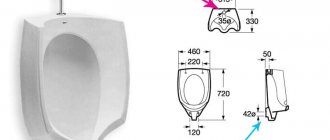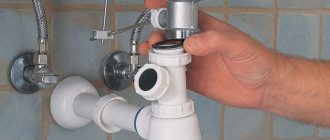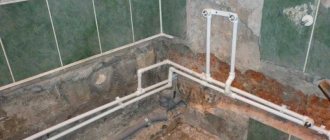There is an opinion that sewer ventilation in a private house, the scheme of which is developed at the building design stage, is necessary only for large cottages with several floors and a large number of plumbing structures. In fact, ensuring the flow of air and the removal of generated gases is necessary for any sewer system, although the design may vary significantly depending on individual conditions. The presence of ventilation, first of all, allows you to ensure a balance of pressure in the sewerage system. Thanks to this, it is possible to avoid the penetration of unpleasant odors into living spaces and the appearance of unpleasant sounds of water suction when low pressure zones form.
Sewage ventilation device
Sewer ventilation in a private house can be done with your own hands, regardless of the number of storeys of the house and the number of drain points, it is only important to correctly develop the scheme. There are two possible options - using fan pipes and using vacuum valves . Before you make a choice, you should know that the current building codes list the conditions under which it is mandatory to install vent pipes.
These include:
- the presence of several floors in the house with drain points located above the level of the 1st floor,
- the diameter of the risers is more than 0.5 m.
In other cases, the homeowner has the right to limit himself to a simpler scheme, however, experts emphasize a noticeable decrease in the efficiency of the sewer system when using only valve devices . Whether sewer ventilation is needed in a private house using vent pipes, if its presence is not required by the rules, is up to the homeowner to decide, but he must take into account that the valves are not a complete replacement and cannot guarantee the occurrence of odors or extraneous noise.
The photo shows a diagram of a sewer hood in a private house with a ventilation pipe when using a septic tank as a treatment facility
Why is ventilation needed?
Of course, sometimes removing sediment alone is not enough. The above-mentioned bacteria can bring not only benefits, but also significant harm. All you need to do for this is not to deal with the air exchange system. The fact is that during waste processing, bacteria release gases that can harm human health. First of all, these are hydrogen sulfide and methane. In addition to them, phosphorus, arsenic salts and other substances with carcinogenic effects sometimes accumulate. And all this is very dangerous! Methane, for example, can lead to an explosion. Therefore, septic tank ventilation is also an important part of the fire protection system.
Some people who claim to understand the design of a septic tank well claim that ventilation is not needed at all. They say that a sufficient amount of clean air penetrates inside through the hatch covers. In fact, this is not true at all. Even if the lids allow some small fraction of oxygen to pass through, this fraction is so insignificant that it is simply not able to save the situation. The required amount of ventilation cannot be achieved in this way. Septic tanks must be equipped with ventilation.
We recommend that you familiarize yourself with: Types of air ducts for kitchen hoods, installation features
Ventilation with exhaust pipe
In addition to the advantages listed above, ventilation systems with waste pipes ensure the correct operation of the sewer system, for which in this case it becomes less dangerous for the siphons to dry out. If the plumbing has not been used for several days and the siphon (hydraulic seal) has dried out, if there is a ventilation pipe in the system, warm air from the sewer will rise and exit up the pipe. Since dry siphons cannot perform their functions as a water barrier between the sewer system and the room, in the absence of a drain pipe, odors will enter the house.
The water seal and vent pipe work together to protect your home from unpleasant sewer odors.
Installation rules
The ventilation pipe may be made of the same material as the sewer pipe. This makes it easy to seal the joints. Due to their low weight, which is important when installing and operating vertical structures, plastic products are often chosen for these purposes. When choosing, you should also take into account that the diameter of the ventilation outlet should not be less than the diameter of the largest riser .
Following certain rules, it is not difficult to understand how to install sewer ventilation in a private house.
- The risers and fan terminals are connected into a single system. If there is a large horizontal distance between individual risers, it is advisable to install several fan pipes.
- It is advisable to install the sewage system during the construction stage. This will reduce labor intensity and make the system more convenient.
- When constructing a building, a special channel and hatches are organized to install a ventilation pipe. If the sewerage system and its ventilation are installed in an already built house, the line can be laid not through the ceilings (this option can reduce the strength and reliability of the structure), but through the wall.
- When developing sewer ventilation in a private house, the scheme must provide for maintaining a horizontal distance from the outer sections of the pipe to balconies and windows of at least 4 m, otherwise it cannot be guaranteed that unpleasant odors will not penetrate the house.
- The height of the exhaust pipe outlet to the roof depends on the roof structure and varies from 0.2 to 3.0 meters. In particular, for flat roofs it is enough that the upper part of the pipe is 300 mm higher than the roof level, and for a pitched structure the height should be no less than 500 mm. And if the roof is used - 3 meters.
- If ventilation pipes from residential premises or chimneys are led onto the roof, the sewer exhaust pipe should be higher than all the others to prevent unpleasant odors from the sewer from entering the house.
- Installing a deflector on a pipe does not increase the efficiency of ventilation of the sewer system, but can cause the formation of ice from frozen condensate during the cold season.
Proper Septic Tank Ventilation
So, we learned that there are several levels of air purification in septic tanks. Ventilation of a septic tank differs with different systems. In tanks with just one level of purification, there is only one type of bacteria. If they need oxygen, then you need to take care of its constant supply. If the opposite is the case, then you must remember to pump out the methane (which, as is already known, can harm health and property).
In tanks with multiple levels of filtration, the system is always more complex and requires maintenance. Oxygen is supplied to each part, and all this requires a power calculation. And if we are talking about a multi-stage system itself, where there is a filtration field (several layers of sand and crushed stone, treated water enters this soil), then everything is even more complicated. Therefore, you need to know the structure of your septic tank and always ensure that it is working properly.
We recommend that you read: Hood in the chicken coop
Using Vacuum Valves
An alternative to a sewer drain can be the installation of vacuum valves, however, professionals recommend choosing this option only if installing a drain pipe is technically impossible or economically infeasible.
Ventilation valve
Operating principle
The valve leaf is connected to a spring that has a slight resistance, and the hermetically sealed seal prevents air from leaking when the device is closed. If a vacuum occurs in the system after the valve (often caused by flushing water under pressure - flushing a toilet or draining water from a washing machine using a pump), the valve automatically opens and allows air from inside the house into the sewer system, restoring the balance. When pressure equilibrium is reached before and after the vacuum valve, the valve closes hermetically again. Through a closed vacuum valve, unpleasant odors cannot enter the room, and when the valve opens, their penetration is prevented by air flow directed in the opposite direction.
When installing equipment of this type, you should remember some of the nuances of operating such systems.
- The presence of valves cannot prevent the penetration of odors from the sewer system into the house if the siphons are dry.
- Vacuum valves are usually mounted on risers, however, if this installation method is difficult for any reason, they can be installed on any of the horizontal sections of the sewer system.
Note: Installing water seals will in any case increase the efficiency of the system, regardless of whether it uses a ventilation pipe or a vacuum valve.
You will find more information about the sewer aerator in another article on the site.
We also have a separate, more detailed material about the sewer pipe.
To avoid unpleasant odors, you definitely need to use a siphon. Read here how to select and install it in the kitchen.
Non-standard ventilation solutions for sewer systems
Non-standard solutions, which at the same time do not contradict safety rules and sanitary requirements, can be a solution if a sewer hood in a private house is installed after the building itself is built. Under such conditions, the implementation of the classical scheme can cause certain difficulties.
Installation on the external wall of the house
If the ventilation pipe is routed along the outer wall of the building, from the outside it will resemble a regular drain and will not spoil the appearance of the house. The only difference will be the height of the upper part, which in any case will be above the roof level. The most common pipe diameter for such sewer ventilation is 110 mm. When choosing an installation location, you must comply with the requirements regarding the permissible distances between the fan outlet and windows (balconies, loggias) specified above.
Fence installation
Installing a drain pipe and fixing it on a fence is virtually no different from installing it on an external wall. The only feature is the greater distance of the ventilation outlet from the building. When choosing this option, it is important to take into account the location of the house and outbuildings on the neighboring site. Don't bother your neighbors with the smell from your sewer.
Ventilation to the septic tank
A sewer ventilation system in a private house, connected to a septic tank, in some cases may be considered the best option. Purification devices and storage tanks, according to the rules, must be installed at a certain distance from the house (depending on individual conditions - from 5 to 20 meters). This ensures that no unpleasant odors enter the house. In addition, it is not difficult to draw a similar conclusion during the construction of a house, when renovating and improving living conditions.
Various options for implementing ventilation for sewerage in a country house and in the country
Before choosing the most suitable ventilation scheme for the sewer system of a private house, it is necessary to carefully study all the existing conditions and nuances of operating the existing sewer system.











